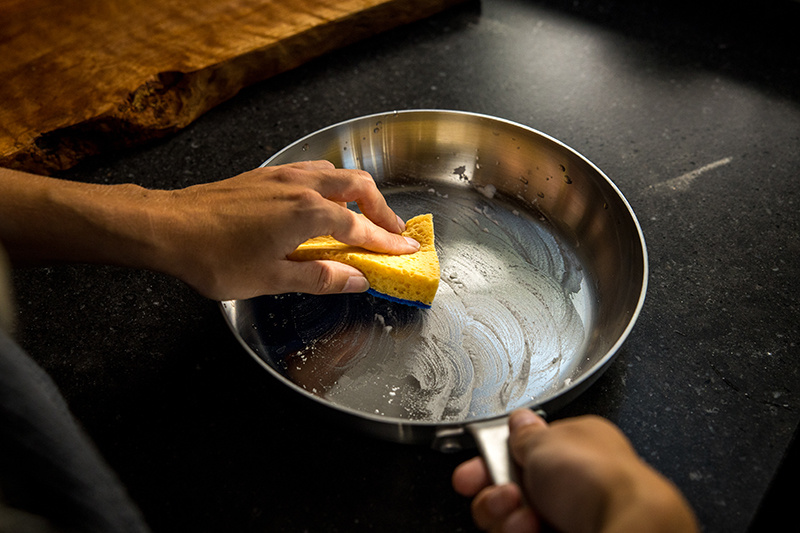Stainless Steel Cookware
What a lovely, big, stainless steel pan you have there. We expect you'll want to get down to business as soon as possible. So we won't waste any time on long-winded instructions for use. But we do have some advice for you. So listen and learn!
First steps for lifelong enjoyment
Follow the advice below to get the most out of your stainless steel pan for longer. Running into problems? Then get in touch — we're here to help. Ready, set and want to go? Check out our blog or knowledge base for some helpful advice.

This is what you really need to know about your stainless steel pan
When using your stainless steel pan, there are three main phases: 'before cooking', 'during cooking' and 'after cooking'. We have compiled the most important tips for you that will increase the lifespan of your pan, so you can enjoy it for a lifetime.
Before you start cooking
- Ingredients at room temperature
To start with, make sure the ingredients are at room temperature, and pat them dry before adding to the pan. - Let the pan warm up first
Let your pan warm up slowly and don't add oil or butter until it hits the right temperature. - How to tell a stainless steel pan is hot enough?
Splash a little water into the pan; if the droplets dance around, it's at the right temperature. If they turn to steam only slowly, it needs to be warmer; if they boil straight off, the pan is too hot.
While cooking
- Add extra oil or butter
Do this with protein-rich foods such as eggs, pancakes, meat and fish. Extra oil or butter, along with the natural non-stick coating, ensures nothing sticks to the bottom. - Be patient
Should food stick to the pan, resist the urge to scrape it. Instead, let it continue cooking. You can also lower the heat and be patient; often, the food will release on its own. - Don't use salt
Stainless steel pans hate salt. So don't sprinkle salt over your food until it's cooked. This avoids salt pitting the bottom.
After cooking
- Make a sauce
Clean your pan a little by cooking a sauce in the same pan. Add warm water to the pan and stir briefly. The pan will be almost clean, and you get a quick, easy sauce! - Prevent a warped pan
Always let pans cool down slowly before cleaning. If you put them straight under or into cold water, they can warp. - Washing up
Be gentle with pans and clean with washing-up liquid and a sponge. Are you a little lazy, perhaps? If so, just rinse them off and put them through the dishwasher.
Putting through the dishwasher
- Dishwasher v. washing by hand
Stainless steel pans are the only ones you can put in the dishwasher. So no need to worry about putting stainless steel pans in the dishwasher. The pans will last just as long. Although stainless steel pans do last better if washed by hand every now and then. - Fed up with water marks?
To avoid water marks on pans after dishwashing, rinse them with supermarket sparkling water and dry immediately with a tea towel to eliminate any residue.
Washing by hand
- Do the dishes!
Wash pans by hand once they've cooled down. Use warm water and a washing-up brush. Washing-up liquid is fine, but no ammonia or bleach! - Do you often find stubborn dirt or scorch marks?
Add a little water to the base of the pan along with a scoop of soda or some vinegar, warm it through then scrub with a sponge. - Keep thoroughly dry
Dry pans with a tea towel. If you let pans air dry, water spots can appear.
Useful links







